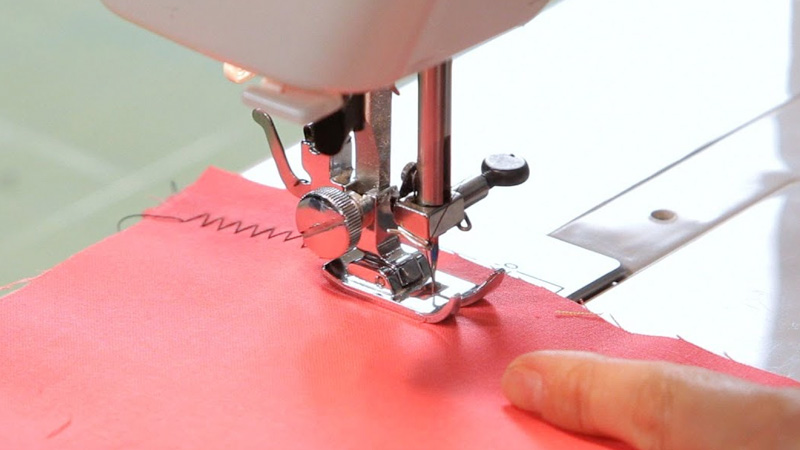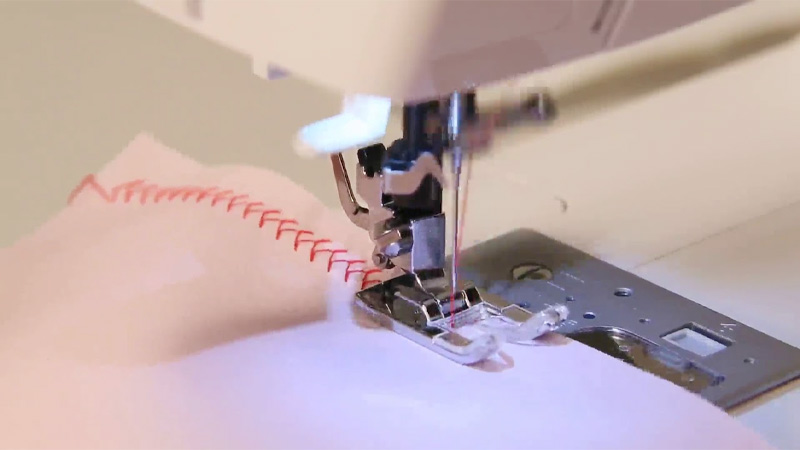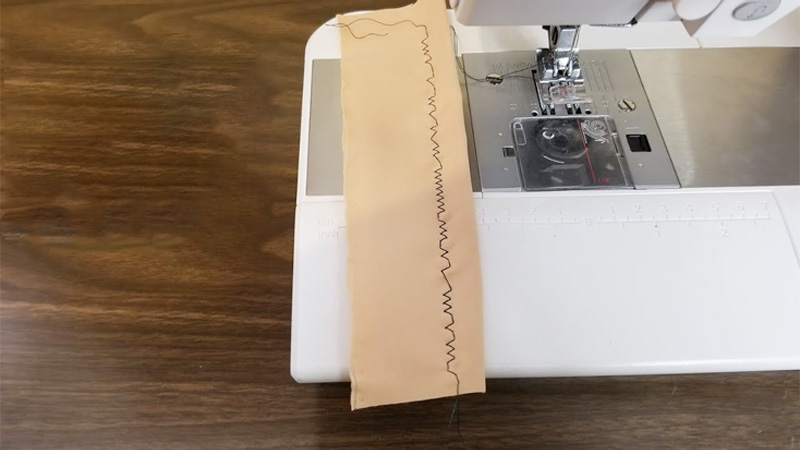The standard zigzag foot, often included with sewing machines, is a versatile and essential accessory that opens the door to a world of creative sewing possibilities.
Whether you’re a sewing novice or a seasoned pro, understanding how to effectively utilize this foot will greatly enhance your sewing projects.
In this comprehensive guide, we will unravel how to use the standard zigzag foot, exploring its features and demonstrating its various functions.
From securing seams and preventing fabric fraying to decorative embellishments and buttonhole creation, the standard zigzag foot is your trusty companion for a wide range of sewing tasks.
Join us on this journey as we delve into the fundamentals of using the standard zigzag foot, offering tips and techniques that will empower you to achieve professional results.
Whether you’re stitching garments, crafting accessories, or mending fabrics, this guide will help you make the most of this indispensable sewing tool.

How to Use the Standard Zig Zag Foot?
Using the standard zigzag foot on your sewing machine is a fundamental skill for various sewing tasks. Here’s a step-by-step guide on how to use it:
Attach the Zigzag Foot
Start by selecting the standard zigzag foot that came with your sewing machine or purchasing one if it’s not included. Attach it to your sewing machine’s presser foot holder following the machine’s instructions. Make sure it’s securely in place.
Select a Zigzag Stitch
Set your sewing machine to a zigzag stitch. On most machines, you can find this option on the stitch selector dial or screen.
Adjust the stitch width and length settings to achieve your desired zigzag pattern. For general sewing, a medium-width and medium-length zigzag stitch often works well.
Insert the Fabric
Thread your sewing machine with the appropriate thread for your project. Consult your sewing machine manual for guidance on threading.
Place your fabric under the presser foot, aligning it with the guidelines on your machine’s throat plate. Lower the presser foot lever to hold the fabric in place.
Start Sewing
Begin sewing by gently pressing the foot pedal or using the start button, depending on your machine’s setup. As the needle moves from side to side, it will create a zigzag stitch, securing the fabric’s edges and preventing fraying.
Guidance and Control
Keep the fabric moving steadily and evenly under the zigzag foot. You can guide it in a straight line or make controlled curves and turns, depending on your project’s requirements.
Finishing the Seam
When you reach the end of your seam, use the machine’s reverse function or sew a few stitches backward and forward to secure the stitching. Lift the presser foot and carefully remove your fabric.
Experiment with Decorative Stitches
Beyond seam finishing, the zigzag foot allows you to create decorative stitches. Experiment with different stitch widths, lengths, and combinations to add unique patterns to your projects.
Buttonholes
The zigzag foot can also be used to create buttonholes. Refer to your sewing machine manual for specific instructions on buttonhole settings and techniques.
Practice and Mastery
Like any sewing skill, practice is key to mastering the use of the standard zigzag foot.
As you gain experience, you’ll become more confident in using it for various sewing tasks, from securing seams to adding decorative flair.
By following these steps and experimenting with different settings, you’ll harness the versatility of the standard zigzag foot to enhance the quality and creativity of your sewing projects.
Do I Need a Special Foot to Sew Zig Zag?

No, you do not need a special foot to sew a zigzag stitch on a sewing machine. Most sewing machines come with a standard zigzag foot as part of their basic accessories.
This standard zigzag foot is versatile and suitable for a wide range of sewing tasks, including sewing zigzag stitches. Here’s what you can do with the standard zigzag foot;
Zigzag Stitch
Securing Seams
Zigzag stitches are often used to secure the edges of fabric seams, preventing them from unraveling.
This is particularly useful for fabrics that tend to fray, like lightweight woven materials.
Adding Stretch
Zigzag stitches have a bit of natural stretch, making them suitable for sewing stretch fabrics, such as knits.
They allow the fabric to stretch without breaking the stitches, making them ideal for sewing activewear, swimwear, or garments that require flexibility.
Reinforcing Stress Points
Zigzag stitches can reinforce stress points on garments, like pockets or areas subject to frequent movement. This added strength helps prevent seam failure.
Basic Decorative Stitches
Embellishments
While the primary purpose of zigzag stitches is functional, they can also be used decoratively. Adjusting the stitch width and length allows you to create various zigzag patterns on your fabric.
These can be used for decorative hems, embellishments on clothing or accessories, or adding a unique touch to home decor projects.
Pintucks and Tucks
Zigzag stitches can be used to create pintucks or tucks in fabric, adding texture and visual interest to your sewing projects.
Experimenting with different stitch settings can yield creative results.
Buttonholes
Many sewing machines include a buttonhole function that utilizes the zigzag foot. By following your sewing machine’s buttonhole settings and guidelines, you can easily create precise and neatly finished buttonholes for your garments, ensuring secure button attachment.
While the standard zigzag foot is versatile, there are specialty presser feet available for certain advanced techniques or decorative effects, like cording, piping, or specific embroidery stitches.
However, for most sewing tasks, the standard zigzag foot that comes with your machine is sufficient. If you find yourself frequently needing a particular specialty foot, you can purchase it separately to expand your sewing capabilities.
Why Is My Sewing Machine Not Doing a Zigzag Stitch?

If your sewing machine is not producing a zigzag stitch when you’ve selected this stitch type, there could be several reasons for the issue.
Here are some common troubleshooting steps to help you identify and resolve the problem:
Check Stitch Selector
Ensure that you have correctly selected the zigzag stitch on your sewing machine. Sometimes, the stitch selector may not be set to the zigzag option, causing the machine to sew a straight stitch.
Stitch Width Setting
Verify that the stitch width setting is appropriately adjusted. If the width is set to zero or a very low value, the machine will sew a straight stitch instead of a zigzag.
Stitch Length Setting
Confirm that the stitch length setting is not at its minimum. If the stitch length is set too short, it might appear as if the machine is not creating a zigzag. Adjust the stitch length to your desired setting.
Thread Tension
Check the thread tension. Incorrect thread tension can affect the appearance of zigzag stitches. Ensure that the upper and lower thread tensions are correctly balanced for your fabric and thread type.
Thread Jam or Tangles
Inspect the threading of your sewing machine, both in the upper thread path and the bobbin area. Thread jams or tangles can prevent the machine from sewing properly. Re-thread the machine carefully, following the manufacturer’s instructions.
Bobbin Winding
If the bobbin thread is not wound evenly on the bobbin, it can lead to stitching issues. Rewind the bobbin thread evenly and ensure it’s inserted correctly in the bobbin case.
Needle and Machine Condition
Check the needle. A damaged or bent needle can affect stitch quality. Replace the needle if it’s dull or damaged.
Regularly clean and maintain your sewing machine. Lint buildup, dust, or debris in the machine’s mechanisms can interfere with proper stitch formation.
Mechanical Issues
If none of the above solutions work, there may be a mechanical issue with your sewing machine, such as a timing problem.
In this case, it’s advisable to consult your sewing machine’s manual for troubleshooting or consider seeking professional servicing.
By carefully checking these factors and making adjustments as needed, you should be able to resolve the issue and get your sewing machine back to producing beautiful zigzag stitches.
FAQs
What is a standard zigzag foot used for?
The standard zigzag foot is a versatile sewing machine accessory used for a variety of tasks.
It’s primarily used for straight stitching and zigzag stitching but can also be used for other decorative and utility stitches.
How do I attach the standard zigzag foot to my sewing machine?
To attach the standard zigzag foot, make sure your machine is turned off, raise the presser foot, and then align the foot’s shank with the presser foot holder.
Lower the presser foot holder to secure the foot in place. Ensure it’s tightly attached before sewing.
What settings should I use with the standard zigzag foot?
The settings depend on your project. For basic straight stitching, set your machine to a straight stitch. For zigzag stitching, select the zigzag stitch on your machine and adjust the width and length as needed for your project.
Can I use the standard zigzag foot for sewing buttons?
Yes, you can use the standard zigzag foot for sewing buttons. Set your machine to the zigzag stitch, adjust the stitch width to match the buttonholes’ size, and then place the button under the foot. The zigzag stitch will secure the button in place.
Are there any tips for using the standard zigzag foot effectively?
Here are a few tips: practice on scrap fabric to get comfortable with different stitch widths and lengths.
Use the right needle for your fabric type. Keep an eye on thread tension to avoid puckering or loose stitches.
Conclusion
As you’ve discovered, the standard zigzag foot is an invaluable ally in the world of sewing.
It’s a tool that not only simplifies essential tasks like securing seams and preventing fraying but also adds a touch of creativity to your projects through decorative stitching and buttonhole creation.
By mastering the use of the standard zigzag foot, you’ve gained the confidence to take on a wide range of sewing challenges.
Whether you’re hemming, mending, quilting, or embellishing, this foot offers versatility that can’t be overstated.
Remember that practice is key to becoming proficient with the standard zigzag foot. As you continue to experiment and explore its capabilities, you’ll find new and exciting ways to elevate your sewing creations.
So, equip your sewing machine with the standard zigzag foot, embark on your sewing adventures, and let your creativity soar. With this newfound knowledge, your sewing projects are bound to be both functional and beautifully embellished.
Leave a Reply